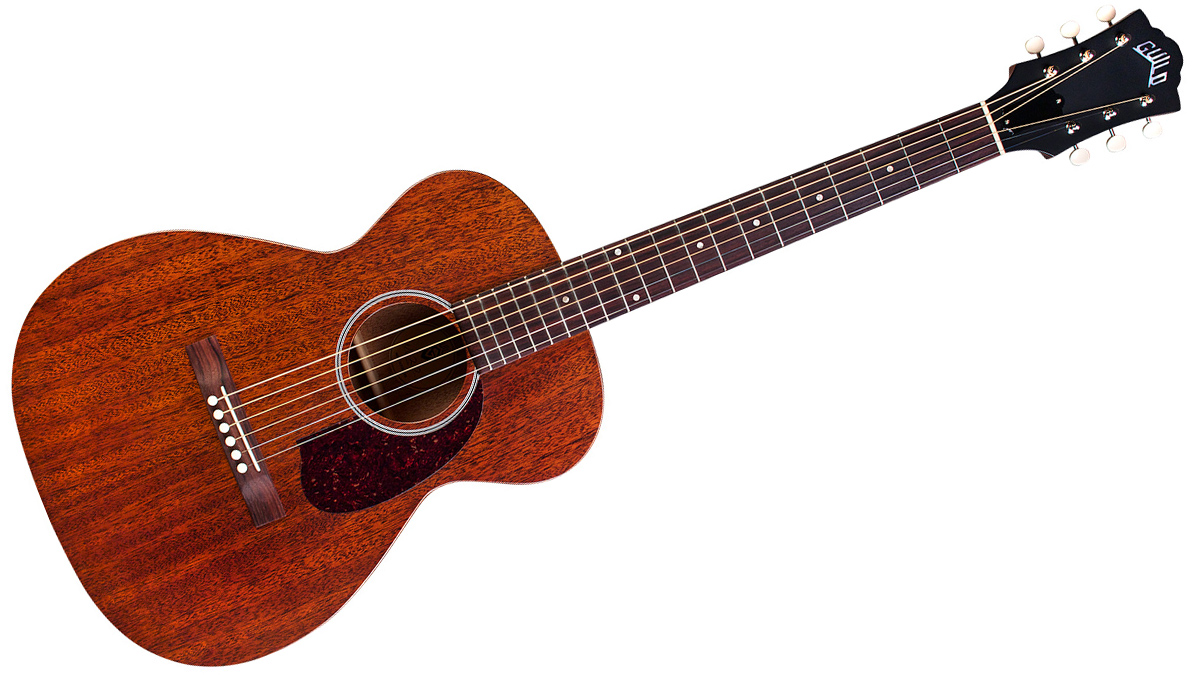MusicRadar Verdict
Build quality is tip-top and price point is very competitive for a premium-marque all-solid build.
Pros
- +
Clean, no-nonsense build at attractive price with engaging fingerstyle, friendly voice and feel.
Cons
- -
Might be a little too mellow for some players.
MusicRadar's got your back
Guild entered the flat-top steel-string market in 1954 with a limited production range of three body sizes: the 15-inch-wide Aragon F-30; the 16-inch Valencia F-40; and the 17-inch Navarre F-50 modelled on Gibson's SJ-100 with a pressed maple laminate arch back (like all of the trio).
The smallest 13.75-inch- wide 'Troubador' F-20 didn't appear until 1956 and was a big-selling guitar for Guild, along with the more 000/OM sized F-30, during the folk boom of the 60s. At this point, all of Guild's flat-tops utilised spruce tops, though the back and sides of the F-30 and F-20 had changed to mahogany by 1959.
It seems the all-mahogany 'Economy' M-20 appeared around 1958 and the all-mahogany 'Del Rio' M-30 a little later.
The story goes that when Guild opened its Westerly, Rhode Island, facility in 1967, it was the M-20 guitar that was first to roll off the production line in the August. Indeed, the M-20 and Mark I classical guitar (both all- mahogany with matt finishes) were the only guitars the new facility produced for some time. They were "the logical choice [with which] to train the new employees and to streamline the production procedures", says Guild historian Hans Moust.
Guild has celebrated its return to USA building with a flourish, reintroducing this model with a lot of history behind it.
Back in the present and now that Guild has once again restored US production, it was decided that the brand new M-20 should follow suit and be the first acoustic guitar to meet the guitar pickin' folks worldwide. The M-20 is famously pictured on the cover of Nick Drake's Bryter Layter record (although there seems to be some discussion as to whether he used it on the album itself ).
First impressions count for a lot, and on first look the M-20 is a very neat-looking small-body concert-size guitar with a huge dollop of vintage chic, thanks in part to its dark chocolatey hue and plain old-world design.
The guitar is built from solid mahogany - in fact, at this point in a review, we'd usually be giving you a full rundown of the bodywoods in use here, but, to be perfectly honest, it's easier to say which parts of this one aren't made from mahogany. That would be the rosewood fingerboard and bridge, then!
Other features include scalloped X bracing, bone nuts and bridge saddles, ivory-coloured bridge pins, a 305mm (12-inch) fingerboard radius, what Guild classes as 'C' profile necks, pearloid dot inlays and vintage-style open gear tuners.
Sounds
The neck shape is certainly quite Guild, a 'C', yes, but with quite steep shoulders giving it a little more 'D' in terms of feel. It had a very mainstream depth, too, very comfortable in the hand.
The M-20, the wider nut width and string spacing combined with a shorter scale seems to spell out 'fingerpicker friendly' from the outset and, on picking it up, this is something that is quickly confirmed. It's a very comfortable guitar to sit and play, and great for playing all of your favourite blues licks.
Guild has celebrated its return to USA building with a flourish, reintroducing this model with a lot of history behind it. With all-mahogany guitars enjoying something of a renaissance, this model will stand tall and speak loud.
Of course, this is just the start of what owners Cordoba hope will become - as its heritage warrants - a major challenge to the USA's other, more established brands. The next models planned for USA production are the D-55 and the F-512 12-string. Watch this space!
“Excels at unique modulated timbres, atonal drones and microtonal sequences that reinvent themselves each time you dare to touch the synth”: Soma Laboratories Lyra-4 review
“I used everything I knew about music”: How Green Day exceeded expectations with their most ambitious song
YouTube just added AI tools that makes musicians, library music and video editors redundant










